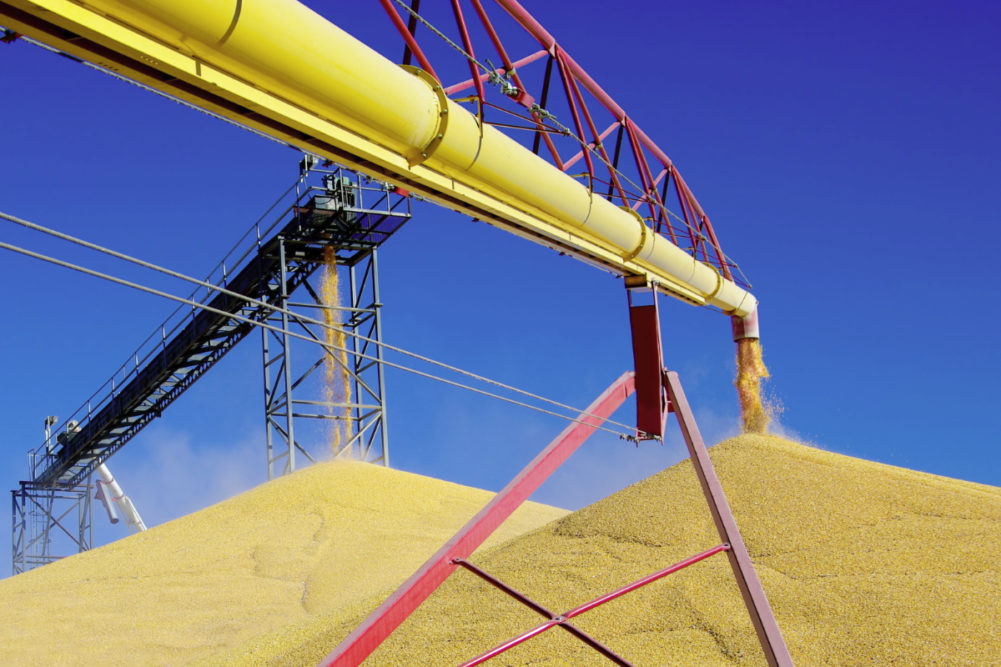LONDON, ENGLAND — As the number of coronavirus (COVID-19) cases and deaths continue to mount, an official from the United Nations’ Food and Agriculture Organization said the global grain industry is in a good position to help feed the world during this expanding pandemic that appears to have no end in sight.
Josef Schmidhuber, deputy director of FAO’s trade and market division, said during an April 17 webinar sponsored by Global Grain that the world is in a much better grain stocks position than it was during the last major economic crisis, the Great Recession of 2007-09.
“We have rather ample stocks at multi-year highs,” he said. “We have to be careful making statements that we are drowning in stocks, but overall, compared to 2007-08, we have twice as high of stocks at absolute levels.”
Current global grain stocks stand at approximately 850 million tonnes, compared to a stockpile of about 470 million tonnes at the start of the Great Recession. The low amount of grain stocks, coupled with high demand for corn in what was then a booming ethanol market, led to soaring grain prices and food inflation that severely impacted food security in a number of developing countries for several years.
Today, in part due to shelter-at-home orders in many of the world’s largest economies, demand for fuel has plummeted, sending oil prices into negative territory for the first time ever. The oil market collapse has led to the temporary closing of a number of biofuels plants around the world. Grain prices also have been driven downward, with corn futures trading at $3.32 per bushel on April 20, the lowest level in four years and far below the high of $7.58 per bushel in June 2008.
Schmidhuber said there is plenty of grain to meet the growing demand for durable, inexpensive grain-based products as much of the global population, including some who are recently unemployed, isolates at home and waits for the pandemic to subside.
He noted that grain production, processing and transportation is much less labor intensive compared to the vegetable or fruit industries, which makes a serious glitch in the supply chain less likely.
“A lot of (grain) trade takes place in bulk shipments,” Schmidhuber said. “It is a highly capital intensive and highly automatized process with relatively little human interaction. It will be hard to disrupt bulk shipments.
“There is the possibility that, due to health reasons and strikes, supply chains could be disrupted. But it’s not likely to impact bulk shipments as strongly as it would for ship containers or trucks, for instance.”
One caveat to this optimistic scenario, Schmidhuber said, is if several of the world’s top grain exporters opt to limit or even prohibit exports for long periods of time due to concerns about their domestic food supply. Already Russia, the world’s top wheat exporter, has indicated it will stop exporting wheat from mid-May through June 30, the end of the current marketing year.
“There is a growing concentration of stocks held by fewer countries,” he said, noting that five countries hold 73% of the world’s grain, up from 64% during the Great Recession of 2007-09. “Equally important is that some of the countries that have the biggest stocks, such as China and India, are among the biggest stockholders, and that is a problem for world markets since these countries are not typically as responsive to changes in world markets as others like the United States and Brazil. That is a bit of a worry that we should not completely ignore.”
Schmidhuber did not have comforting words for the global biofuels industry, and he spoke several days before the oil markets crashed on April 20, with per-barrel oil prices plummeting below zero. Ongoing concerns over swelling oil inventories pushed West Texas Intermediate crude for May delivery to a record low -$36.73 per barrel. At a price below zero, buyers would be paid to take delivery as there are costs associated with transportation and storage.
“I think perhaps it is the beginning of the end for a considerable part of the biofuels sector,” he said. “If that comes to pass, we will see a change in relative prices within agriculture. Those who are older than I am will remember that price ratios of wheat and maize used to be much wider than they are today. Without biofuels, I think you would see a return to a much wider ratio.”
Looking at the big picture, Schmidhuber referenced a recent paper from the International Monetary Fund (IMF) that compared the current crisis to the Great Recession. The biggest difference, he said, is that the COVID-19 crisis is truly international in scope, while the 2007-09 recession mainly impacted the highly developed economies associated with sub-prime mortgage crisis that originated in the United States.
“This is going to be a much bigger contraction than what we saw during the financial crisis,” he said. “The IMF’s projected cumulative losses are a huge number — about $9 trillion — which is about 40% of GDP in the US.”
However, the IMF also projects a relatively quick recovery in which global GDP will rebound from minus 3% in 2020 to 5.8% in 2021. The quick rebound is based on a COVID-19 vaccine being developed by the latter part of this year, a timetable that most health experts say may be too optimistic.
Schmidhuber said the IMF is forecasting “an almost V-shaped recovery relative to the current situation and to the Great Recession. I think it’s telling how the markets reacted to this report as nobody pressed the sell button. Quite opposite, markets rallied in the US.”
As of April 20, COVID-19 had infected nearly 2.5 million people worldwide and killed more than 170,00.
Follow our breaking news coverage of the coronavirus/COVID-19 situation.






